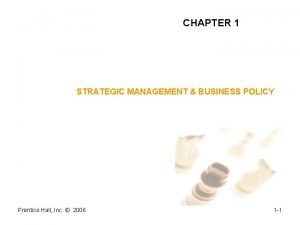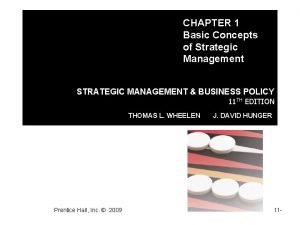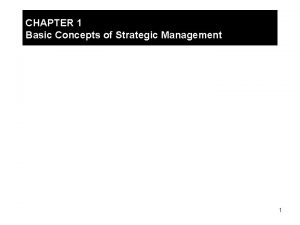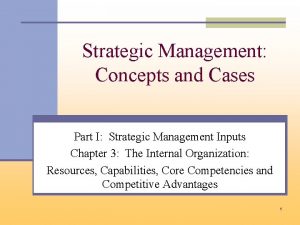Strategic Management Concepts and Cases 9 e Part

























- Slides: 25

Strategic Management: Concepts and Cases 9 e Part II: Strategic Actions: Strategy Formulation Chapter 6: Corporate-Level Strategy © 2011 Cengage Learning. All Rights Reserved. May not be scanned, copied or duplicated, or posted to a publicly accessible website, in whole or in part.

The Strategic Management Process © 2011 Cengage Learning. All Rights Reserved. May not be scanned, copied or duplicated, or posted to a publicly accessible website, in whole or in part.

Chapter 6: Corporate-Level Strategy • Overview: Seven content areas – Define and discuss corporate-level strategy – Different levels of diversification – Three primary reasons firms diversify – Value creation: related diversification strategy – Value creation: unrelated diversification strategy – Incentives and resources encouraging value-neutral diversification – Management motives encouraging firm overdiversification © 2011 Cengage Learning. All Rights Reserved. May not be scanned, copied or duplicated, or posted to a publicly accessible website, in whole or in part.

Foster’s Group Diversification into Wine • Australian beer producer • Entered wine business for growth potential – 2001 purchase of Beringer Wine Estates (California) – 2005 purchase of Southcorp – By 2008 wine contributed 76% of sales earnings • Costly mistakes – One sales force for both beer and wine – Southcorp purchased at a premium during period when U. S. dollar was depreciating vs. Australian dollar © 2011 Cengage Learning. All Rights Reserved. May not be scanned, copied or duplicated, or posted to a publicly accessible website, in whole or in part.

Chapter 6: Corporate-Level Strategy • Overview: Seven content areas – Define and discuss corporate-level strategy – Different levels of diversification – Three primary reasons firms diversify – Value creation: related diversification strategy – Value creation: unrelated diversification strategy – Incentives and resources encouraging value-neutral diversification – Management motives encouraging firm overdiversification © 2011 Cengage Learning. All Rights Reserved. May not be scanned, copied or duplicated, or posted to a publicly accessible website, in whole or in part.

Introduction • Corporate-level strategy: Specifies actions a firm takes to gain a competitive advantage by selecting and managing a group of different businesses competing in different product markets – Expected to help firm earn above-average returns – Value ultimately determined by degree to which “the businesses in the portfolio are worth more under the management of the company then they would be under any other ownership • Product diversification (PD): primary form of corporate-level strategy © 2011 Cengage Learning. All Rights Reserved. May not be scanned, copied or duplicated, or posted to a publicly accessible website, in whole or in part.

Chapter 6: Corporate-Level Strategy • Overview: Seven content areas – Define and discuss corporate-level strategy – Different levels of diversification – Three primary reasons firms diversify – Value creation: related diversification strategy – Value creation: unrelated diversification strategy – Incentives and resources encouraging value-neutral diversification – Management motives encouraging firm overdiversification © 2011 Cengage Learning. All Rights Reserved. May not be scanned, copied or duplicated, or posted to a publicly accessible website, in whole or in part.

Levels of Diversification • 1. Low Levels – Single Business Strategy • Corporate-level strategy in which the firm generates 95% or more of its sales revenue from its core business area – Dominant Business Diversification Strategy • Corporate-level strategy whereby firm generates 70 -95% of total sales revenue within a single business area © 2011 Cengage Learning. All Rights Reserved. May not be scanned, copied or duplicated, or posted to a publicly accessible website, in whole or in part.

Levels of Diversification (Cont’d) • 2. Moderate to High Levels – Related Constrained Diversification Strategy • Less than 70% of revenue comes from the dominant business • Direct links (i. e. , share products, technology and distribution linkages) between the firm's businesses – Related Linked Diversification Strategy (Mixed related and unrelated) • Less than 70% of revenue comes from the dominant business • Mixed: Linked firms sharing fewer resources and assets among their businesses (compared with related constrained, above), concentrating on the transfer of knowledge and competencies among the businesses © 2011 Cengage Learning. All Rights Reserved. May not be scanned, copied or duplicated, or posted to a publicly accessible website, in whole or in part.

Levels of Diversification • 3. Very High Levels: Unrelated • Less than 70% of revenue comes from dominant business • No relationships between businesses © 2011 Cengage Learning. All Rights Reserved. May not be scanned, copied or duplicated, or posted to a publicly accessible website, in whole or in part.

Levels and Types of Diversification © 2011 Cengage Learning. All Rights Reserved. May not be scanned, copied or duplicated, or posted to a publicly accessible website, in whole or in part.

Reasons for Diversification • A number of reasons exist for diversification including – Value-creating • Operational relatedness: sharing activities between businesses • Corporate relatedness: transferring core competencies into business – Value-neutral – Value-reducing © 2011 Cengage Learning. All Rights Reserved. May not be scanned, copied or duplicated, or posted to a publicly accessible website, in whole or in part.

Value-Creating Diversification Strategies: Operational and Corporate Relatedness © 2011 Cengage Learning. All Rights Reserved. May not be scanned, copied or duplicated, or posted to a publicly accessible website, in whole or in part.

Chapter 6: Corporate-Level Strategy • Overview: Seven content areas – Define and discuss corporate-level strategy – Different levels of diversification – Three primary reasons firms diversify – Value creation: related diversification strategy – Value creation: unrelated diversification strategy – Incentives and resources encouraging value-neutral diversification – Management motives encouraging firm overdiversification © 2011 Cengage Learning. All Rights Reserved. May not be scanned, copied or duplicated, or posted to a publicly accessible website, in whole or in part.

Value-Creating Diversification (VCD): Related Strategies • Purpose: Gain market power relative to competitors • Related diversification wants to develop and exploit economies of scope between its businesses – Economies of scope: Cost savings firm creates by successfully sharing some of its resources and capabilities or transferring one or more corporate-level core competencies that were developed in one of its businesses to another of its businesses • VCD: Composed of ‘related’ diversification strategies including Operational and Corporate relatedness © 2011 Cengage Learning. All Rights Reserved. May not be scanned, copied or duplicated, or posted to a publicly accessible website, in whole or in part.

Value-Creating Diversification (VCD): Related Strategies (Cont’d) • 1. Operational Relatedness: Sharing activities – Can gain economies of scope – Share primary or support activities (in value chain) • Risky as ties create links between outcomes – Related constrained share activities in order to create value – Not easy, often synergies not realized as planned © 2011 Cengage Learning. All Rights Reserved. May not be scanned, copied or duplicated, or posted to a publicly accessible website, in whole or in part.

Value-Creating Diversification (VCD): Related Strategies (Cont’d) • 2. Corporate Relatedness: Core competency transfer – Complex sets of resources and capabilities linking different businesses through managerial and technological knowledge, experience and expertise – Two sources of value creation • Expense incurred in first business and knowledge transfer reduces resource allocation for second business • Intangible resources difficult for competitors to understand imitate, so immediate competitive advantage over competition – Use related-linked diversification strategy © 2011 Cengage Learning. All Rights Reserved. May not be scanned, copied or duplicated, or posted to a publicly accessible website, in whole or in part.

Value-Creating Diversification (VCD): Related Strategies (Cont’d) • Market Power – Exists when a firm is able to sell its products above the existing competitive level, to reduce costs of primary and support activities below the competitive level, or both. – Multimarket (or Multipoint) Competition • Exists when 2 or more diversified firms simultaneously compete in the same product or geographic markets. – Related diversification strategy may include • Vertical Integration • Virtual integration © 2011 Cengage Learning. All Rights Reserved. May not be scanned, copied or duplicated, or posted to a publicly accessible website, in whole or in part.

Value-Creating Diversification (VCD): Unrelated Strategies • Creates value through two types of financial economies – Cost savings realized through improved allocations of financial resources based on investments inside or outside firm • Efficient internal capital market allocation – Restructuring of acquired assets • Firm A buys firm B and restructures assets so it can operate more profitably, then A sells B for a profit in the external market © 2011 Cengage Learning. All Rights Reserved. May not be scanned, copied or duplicated, or posted to a publicly accessible website, in whole or in part.

Chapter 6: Corporate-Level Strategy • Overview: Seven content areas – Define and discuss corporate-level strategy – Different levels of diversification – Three primary reasons firms diversify – Value creation using related diversification strategy – Value creation using unrelated diversification strategy – Incentives and resources encouraging valueneutral diversification – Management motives encouraging firm overdiversification © 2011 Cengage Learning. All Rights Reserved. May not be scanned, copied or duplicated, or posted to a publicly accessible website, in whole or in part.

Value-Neutral Diversification: Incentives and Resources • Incentives to Diversify – Antitrust Regulation and Tax Laws – Low Performance – Uncertain Future Cash Flows – Synergy and Firm Risk Reduction – Resources and Diversification © 2011 Cengage Learning. All Rights Reserved. May not be scanned, copied or duplicated, or posted to a publicly accessible website, in whole or in part.

The Curvilinear Relationship between Diversification and Performance © 2011 Cengage Learning. All Rights Reserved. May not be scanned, copied or duplicated, or posted to a publicly accessible website, in whole or in part.

Chapter 6: Corporate-Level Strategy • Overview: Seven content areas – Define and discuss corporate-level strategy – Different levels of diversification – Three primary reasons firms diversify – Value creation using related diversification strategy – Value creation using unrelated diversification strategy – Incentives and resources encouraging value-neutral diversification – Management motives encouraging firm overdiversification © 2011 Cengage Learning. All Rights Reserved. May not be scanned, copied or duplicated, or posted to a publicly accessible website, in whole or in part.

Value-Reducing Diversification: Managerial Motives to Diversify • Top-level executives may diversify in order to diversity their own employment risk, as long as profitability does not suffer excessively – Diversification adds benefits to top-level managers but not shareholders – This strategy may be held in check by governance mechanisms or concerns for one’s reputation © 2011 Cengage Learning. All Rights Reserved. May not be scanned, copied or duplicated, or posted to a publicly accessible website, in whole or in part.

Summary Model of the Relationship Between Diversification and Firm Performance © 2011 Cengage Learning. All Rights Reserved. May not be scanned, copied or duplicated, or posted to a publicly accessible website, in whole or in part.
 Criminal cases vs civil cases
Criminal cases vs civil cases Industrial organization model of above average returns
Industrial organization model of above average returns Tows matrix
Tows matrix According to greenley strategic management
According to greenley strategic management Basic concepts of strategic management
Basic concepts of strategic management Basic concepts of strategic management
Basic concepts of strategic management Basic concept of strategic management
Basic concept of strategic management Basic concept of strategic management
Basic concept of strategic management Strategic management in public sector
Strategic management in public sector Why is not advisable to pursue too many strategies at once
Why is not advisable to pursue too many strategies at once Basic concepts of strategic management
Basic concepts of strategic management Basic concept of strategic management
Basic concept of strategic management 8-4 multiplying special cases
8-4 multiplying special cases Strategic complements
Strategic complements Chapter 2 analyzing transactions
Chapter 2 analyzing transactions Environmental management: readings and cases
Environmental management: readings and cases Jay haley strategic family therapy
Jay haley strategic family therapy Strategic fit vs strategic intent
Strategic fit vs strategic intent Business process management cases
Business process management cases Puppies, pigs, and people: eating meat and marginal cases
Puppies, pigs, and people: eating meat and marginal cases Addition symbol
Addition symbol Part to part ratio definition
Part to part ratio definition Brainpop ratios
Brainpop ratios Technical description meaning
Technical description meaning Parts of the bar drawing
Parts of the bar drawing The phase of the moon you see depends on ______.
The phase of the moon you see depends on ______.

















































